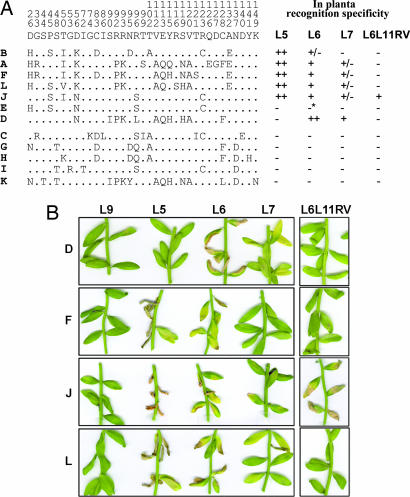Fig. 1.
Amino acid variation between AvrL567 homologs is associated with differences in recognition specificity. (A) (Left) The consensus amino acid at polymorphic positions (numbered vertically above the consensus line) in the AvrL567 proteins is shown above the individual sequences with identical residues indicated by dots. (Right) The columns indicate whether a necrotic response was observed when these proteins were expressed in flax lines containing L5, L6, L7, or the recombinant L6L11RV gene. ++ indicates a very strong necrotic response observed within 4 days; + indicates necrosis observed within 10 days; +/− indicates a chlorotic response observed after 10 days; − indicates no response observed. ∗, A slight chlorotic response was observed for AvrL567-E on L6 in some but not all assays, suggesting very weak recognition. (B) Leaves of near-isogenic flax lines containing the L9, L5, L6, or L7 R genes or transgenic flax plants containing L6L11RV were infiltrated with Agrobacterium cultures containing T-DNA expression vectors encoding the predicted 127-aa mature AvrL567-D, AvrL567-F, AvrL567-J, or AvrL567–L proteins under the control of the cauliflower mosaic virus 35S promoter. Images were prepared 10 days after infiltration.

